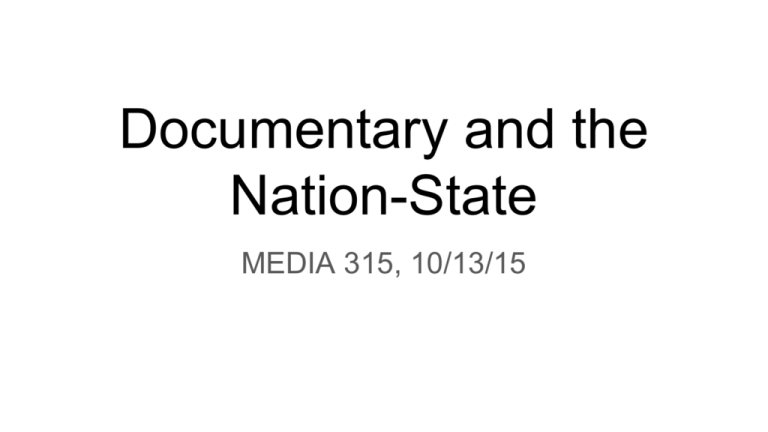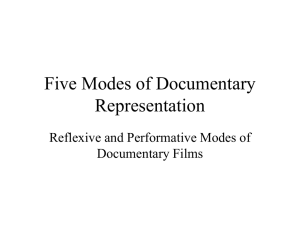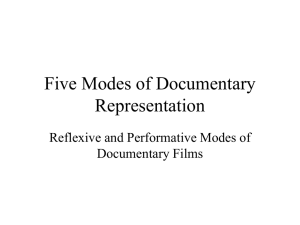slides - WordPress.com
advertisement

Documentary and the Nation-State MEDIA 315, 10/13/15 Midterm Paper, Cont’ … “A specific purpose, such as defending a position, advancing a point of view, or exploring an issue, endows an essay with interest.” - Bill Nichols ● Watch more than once!!!!!!! ● ● ● After first viewing, take notes Review vs. criticism (no need for plot summary) Your opinions matter, but they are not enough. Need to development them into arguments about what the film is doing, supported by evidence. Don’t be afraid of doing additional research on the subject, the filmmaker, or the context. Textual Studies and/vs. cultural studies. ● Making Nations into States and States into Nations Did anyone see the article from a few days ago about GALLUP? Nations and States What can we take away from the recent Gallup news? ● ● A reminder that a phrase like “Most Americans agree that …” would have been meaningless to most Americans before the 1930’s. National identity and communication technologies are intertwined. ○ This reality wasn’t lost on many state leaders and documentarians in the 1920’s and 1930’s. Dziga Vertov (1896 - 1954, Russia, Soviet Union) Social/Historical Influences: Vertov turned 21 in 1917. -What’s so special about that date? portrait of the artist mid-air. Russian Cubo-Futurist/Constructivist Art The Knife Grinder (Malevich, 1913) Taking in the Harvest (Malevich, 1912) Constructivist movie poster for Man WIth A Movie Camera (1929) The Cyclist (Goncharova, 1913) Dziga Vertov (1896 - 1954, Russia, Soviet Union) Social/Historical Influences: ● ● ● ● Vertov turned 21 in 1917. ○ -What’s so special about that date? Lenin: Film is the least bourgeois art form. Much funding early on. Recognition of cinema as a tool of propaganda (in a non-pejorative sense of that term) Agit-train: Connects Space and time ○ speed becomes a defining force of cinema in this mode. Vertov’s Kino Pravda Newsreel operated by the “Council of Three” ● ● ● Focus on Everyday life Rejection of Drama/Theater Kino-eye superior to the human eye, limited by time and space. ○ ○ Combination of camera (able to see at long distances, close up, slowed down, sped up) and editing (manipulation of time and space) As a revolutionary (or potentially revolutionary) tool, perhaps there is a parallel between the way Vertov thought of the camera and the way social media/smart phones are often discussed today as enabling revolutionary moments such as Tahrir Square in Egypt. Man With A Movie Camera (1929) ● ● ● ● ● ● ● ● ● The city as economic engine. Life Caught Unawares (social actors) Anonymity vs. Intimacy of the city (the city is both something to be viewed AND experienced) The Mobile/Slippery Camera ○ Distance is collapsed in modernity. Time governs space. ○ Parallel Action / Editing Everyone Has a Role to Play Kino Pravda = Cinema Verite Self Reflexivity Dziga Vertov = onomatopoeia + “spinning top” Against socialist realism Vertov was reviled in the USSR at the time of his death, but his work was resurrected by Cinema Verite and others … Perry Bard’s MAN WITH A MOVIE CAMERA http://dziga.perrybard.net/ John Grierson (1898 - 1972, Great Britain) ● Founder of British Documentary Movement, at the Empire Marketing Board (1928 - 1934) ● Created the National Film Board of Canada Grierson Influenced by Vertov & Soviets. Also had a love/ hate relationship with Flaherty Love: – Credits Flaherty with creating the first documentary. (financial motivation?) – Ability to go beneath the surface to explore deeper reality. “Creative interpretation” of reality. – Importance of finding story in the location, spending time with people you are filming, letting the story emerge organically. Also a serious interest in the working class on screen. Grierson Critique of Flaherty: – “escapist,” “sen@mental.” Impera@ve to focus on the here and now, the “drama of the doorstep.” Return to reality from romance. – Limitation of focus on individual heroism – no longer able to cross-section “No spear, held however bravely by the individual, will master the crazy walrus of international finance.” – Grierson embraces point of view, anathema to Flaherty. “Propaganda first, art second.” “Cinema as a Pulpit.” ”Art as a hammer, not a mirror.” Grierson’s Mission: Social Cohesion Throughout Empire ● ● Marketing board’s mission was “Consolidation of British Empire through trade and sense of unity among various parts.” Grierson mediated between funders and filmmakers. WATCH: HOUSING PROBLEMS (1935, Edgar Antsey) - Sponsored by BRITISH COMMERCIAL GAS ASSOCIATION - First on-location sync sound film. Grierson on HOUSING PROBLEMS “In Housing Problems, Cockney slum dwellers address the camera directly to explicate the living conditions the film depicts. This was the first time that the working class had been interviewed on film in situ. Giving them a voice by obtaining location sound with the bulky studio optical recording systems of the day was an exercise in technological audacity as great as any in the history of the cinema. Sound had come slowly. In 1934 Grierson was promising, "If we are showing workmen at work, we get the workmen to do their own commentary, with idiom and accent complete. It makes for intimacy and authenticity, and nothing we could do would be half as good." - From Winston’s “Tradition of the Victim in Griersonian Documentary” HOUSING PROBLEMS “If the British films could have been sponsored directly by social organizations fighting the bad housing conditions instead of by a gas company, they would have closed in on such dramatic reality as rent strikes and protest movements.” “If the British films had been sponsored directly by social organisations fighting the bad housing conditions instead of by a gas company, they would have closed in on such dramatic reality as rent strikes and protest movements.’ The issue is not that what Housing Problems shows isn’t true because it isn’t objective, but that what it shows is the result of certain ideological choices. What it shows is a half-truth, and the problem with half-truths is that they tend to show the wrong half.” - Brian Winston THE SONG OF CEYLON (Wright, 1934) Sponsored by the Ceylon Tea Propaganda Board Keys To Watching/Listening: - expressive, non-diegetic soundtrack What is the structure of the film? What is the source of the filmmaker’s authority? How would you characterize the filmmakers’ editorial point of view? benign or malignant modernism? THE SONG OF CEYLON (1934) ● ● ● ● ● ● Taboo for men to work for others Ecstatic evocation of paradise almost lost “coming out of darkness” dream sequence at beginning of film? Whose dream? portrait of a village not entirely cut off from the rest of the world. fusion of romantic lyricism of Flaherty and synthetic brilliance of Vertov. “I think Song of Ceylon is the work of a young man exposed for the first time to an oriental as opposed to occidental way of life, and to a very impressive and convincing oriental religion . . . . Without any question it’s the only film I’ve ever made that I can bear to look at.” - Basil Wright “Buddhism and the art of life it has to offer, set upon by a Western metropolitan civilization which, in spite of all our skills, has no art of life to offer.” - John Grierson






